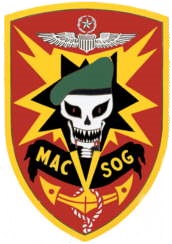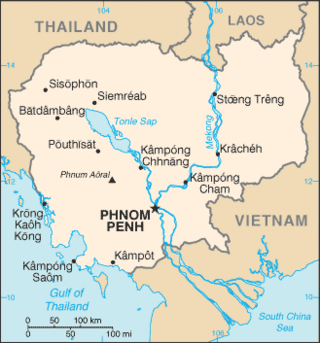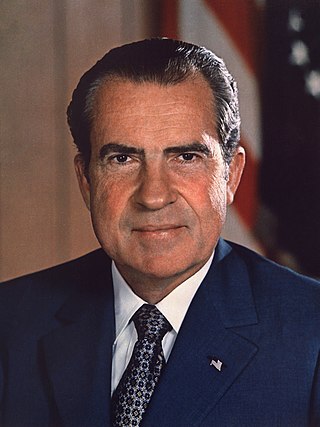
The Vietnam War was a conflict in Vietnam, Laos, and Cambodia from 1 November 1955 to the fall of Saigon on 30 April 1975. It was the second of the Indochina Wars and was a major conflict of the Cold War. While the war was officially fought between North Vietnam and South Vietnam, the north was supported by the Soviet Union, China, and other communist states, while the south was supported by the United States and other anti-communist allies, making the war a proxy war between the United States and the Soviet Union. It lasted almost 20 years, with direct U.S. military involvement ending in 1973. The conflict also spilled over into neighboring states, exacerbating the Laotian Civil War and the Cambodian Civil War, which ended with all three countries officially becoming communist states by 1976.

Lê Đức Thọ, born Phan Đình Khải in Nam Dinh Province, was a Vietnamese revolutionary general, diplomat, and politician. He was the first Asian to be awarded the Nobel Peace Prize, jointly with United States Secretary of State Henry Kissinger in 1973, but refused the award.

Melvin Robert Laird Jr. was an American politician, writer and statesman. He was a U.S. congressman from Wisconsin from 1953 to 1969 before serving as Secretary of Defense from 1969 to 1973 under President Richard Nixon. Laird was instrumental in forming the administration's policy of withdrawing U.S. soldiers from the Vietnam War; he coined the expression "Vietnamization," referring to the process of transferring more responsibility for combat to the South Vietnamese forces. First elected in 1952, Laird was the last living Representative elected to the 83rd Congress at the time of his death.

John Cornelius Stennis was an American politician who served as a U.S. senator from the state of Mississippi. He was a Democrat who served in the Senate for over 41 years, becoming its most senior member for his last eight years. He retired from the Senate in 1989, and is, to date, the last Democrat to have been a U.S. senator from Mississippi. Furthermore, at the time of his retirement, Stennis was the last senator to have served during the presidency of Harry S. Truman.

The Paris Peace Accords, officially the Agreement on Ending the War and Restoring Peace in Viet Nam, was a peace agreement signed on January 27, 1973, to establish peace in Vietnam and end the Vietnam War. The agreement was signed by the governments of the Democratic Republic of Vietnam ; the Republic of Vietnam ; the United States; and the Provisional Revolutionary Government of the Republic of South Vietnam (PRG), which represented South Vietnamese communists. US ground forces had begun to withdraw from Vietnam in 1969, and had suffered from deteriorating morale during the withdrawal. By the beginning of 1972 those that remained had very little involvement in combat. The last American infantry battalions withdrew in August 1972. Most air and naval forces, and most advisers, also were gone from South Vietnam by that time, though air and naval forces not based in South Vietnam were still playing a large role in the war. The Paris Agreement removed the remaining US forces. Direct U.S. military intervention was ended, and fighting between the three remaining powers temporarily stopped for less than a day. The agreement was not ratified by the U.S. Senate.
The Cooper–Church Amendment was introduced in the United States Senate during the Vietnam War. The amendment sought to cut off all funding to American war efforts in Cambodia. Its proposal was the first time that Congress had restricted the deployment of troops during a war against the wishes of the president.
The McGovern–Hatfield Amendment was a proposed amendment to an appropriations bill in 1970 during the Vietnam War that, if passed, would have required the end of United States military operations in the Republic of Vietnam by December 31, 1970 and a complete withdrawal of American forces halfway through the next year. It was the most outstanding defiance of executive power regarding the war prior to 1971. The amendment was proposed by Senators George McGovern of South Dakota and Mark Hatfield of Oregon, and was known as the "amendment to end the war."

Military Assistance Command, Vietnam – Studies and Observations Group (MACV-SOG) was a highly classified, multi-service United States special operations unit which conducted covert unconventional warfare operations before and during the Vietnam War.
The Hughes–Ryan Amendment was an amendment to the Foreign Assistance Act of 1961, passed as section 32 of the Foreign Assistance Act of 1974. The amendment was named for its co-authors, Senator Harold E. Hughes (D–IA) and Representative Leo Ryan (D–CA). The amendment required the President of the United States to report all covert actions of the Central Intelligence Agency to one or more Congressional committees.

Operation Menu was a covert United States Strategic Air Command (SAC) tactical bombing campaign conducted in eastern Cambodia from 18 March 1969 to 26 May 1970 as part of both the Vietnam War and the Cambodian Civil War. The targets of these attacks were sanctuaries and base areas of the People's Army of Vietnam and forces of the Viet Cong (VC), which used them for resupply, training, and resting between campaigns across the border in the Republic of Vietnam. The impact of the bombing campaign on the Khmer Rouge guerrillas, the PAVN, and Cambodian civilians in the bombed areas is disputed by historians.

The Cambodian campaign was a series of military operations conducted in eastern Cambodia in mid-1970 by South Vietnam and the United States as an expansion of the Vietnam War and the Cambodian Civil War. Thirteen operations were conducted by the Army of the Republic of Vietnam (ARVN) between April 29 and July 22 and by U.S. forces between May 1 and June 30, 1970.
U-Tapao Royal Thai Navy Airfield is a military airfield of the Royal Thai Navy (RTN) approximately 140 kilometres (87 mi) southeast of Bangkok in the Ban Chang District of Rayong Province near Sattahip on the Gulf of Thailand. It is serves as the home of the RTN First Air Wing.

The Sihanouk Trail was a logistical supply system in Cambodia used by the People's Army of Vietnam (PAVN) and its Viet Cong (VC) guerillas during the Vietnam War (1960–1975). Between 1966 and 1970, this system operated in the same manner and served the same purposes as the much better known Ho Chi Minh trail which ran through the southeastern portion of the Kingdom of Laos. The name is of American derivation, since the North Vietnamese considered the system integral to the supply route mentioned above. U.S. attempts to interdict this system began in 1969.
Operation Freedom Deal was a military campaign led by the United States Seventh Air Force, taking place in Cambodia between 19 May 1970 and 15 August 1973. Part of the larger Vietnam War and the Cambodian Civil War, the goal of the operation was to provide air support and interdiction in the region. Launched by President Richard Nixon as a follow-up to the earlier ground invasion during the Cambodian Campaign, the initial targets of the operation were the base areas and border sanctuaries of the People's Army of Vietnam (PAVN) and the Viet Cong (VC).
United States involvement in the Vietnam War began shortly after the end of World War II in Asia, first in an extremely limited capacity and escalating over a period of 20 years. The U.S. military presence peaked in April 1969, with 543,000 American combat troops stationed in Vietnam. By the conclusion of the United States's involvement in 1973, over 3.1 million Americans had been stationed in Vietnam.

Richard Nixon's tenure as the 37th president of the United States began with his first inauguration on January 20, 1969, and ended when he resigned on August 9, 1974, in the face of almost certain impeachment and removal from office, the only U.S. president ever to do so. He was succeeded by Gerald Ford, whom he had appointed vice president after Spiro Agnew became embroiled in a separate corruption scandal and was forced to resign. Nixon, a prominent member of the Republican Party from California who previously served as vice president for two terms under president Dwight D. Eisenhower, took office following his narrow victory over Democrat incumbent vice president Hubert Humphrey and American Independent Party nominee George Wallace in the 1968 presidential election. Four years later, in the 1972 presidential election, he defeated Democrat nominee George McGovern, to win re-election in a landslide. Although he had built his reputation as a very active Republican campaigner, Nixon downplayed partisanship in his 1972 landslide re-election.
The CIA conducted secret operations in Cambodia and Laos for eight years as part of the conflict against Communist North Vietnam.

1973 in the Vietnam War began with a peace agreement, the Paris Peace Accords, signed by the United States and South Vietnam on one side of the Vietnam War and communist North Vietnam and the insurgent Viet Cong on the other. Although honored in some respects, the peace agreement was violated by both North and South Vietnam as the struggle for power and control of territory in South Vietnam continued. North Vietnam released all American prisoners of war and the United States completed its military withdrawal from South Vietnam.
The US foreign policy during the presidency of Richard Nixon (1969–1974) focused on reducing the dangers of the Cold War among the Soviet Union and China. President Richard Nixon's policy sought on détente with both nations, which were hostile to the U.S. and to each other in the wake of the Sino-Soviet split. He moved away from the traditional American policy of containment of communism, hoping each side would seek American favor. Nixon's 1972 visit to China ushered in a new era of U.S.-China relations and effectively removed China as a Cold War foe. The Nixon administration signed the Anti-Ballistic Missile Treaty with the Soviet Union and organized a conference that led to the signing of the Helsinki Accords after Nixon left office.

American diplomat Henry Kissinger (1923–2023) played an important and controversial role in the Vietnam War. Starting out as a supporter, Kissinger came to see it as a drag on American power. In 1968, Kissinger leaked information about the status of the peace talks in Paris to the Nixon campaign and was rewarded with being appointed National Security Adviser under Richard Nixon. As National Security Adviser, Kissinger sought initially to find a way to end the war on American terms. During his tenure, Kissinger came to differ with Nixon as Kissinger was more in favor of seeking an end to war as expeditiously as possible with minimum damage to American prestige. In October 1972, Kissinger reached a draft agreement that Nixon at first rejected, leading to the Christmas bombings of December 1972. The agreement that Kissinger signed in January 1973—which led to the American withdrawal from Vietnam in March of that year—was very similar to the draft agreement rejected the previous year. As National Security Adviser and Secretary of State, Kissinger favored continued American support for South Vietnam right until the collapse of that state in April 1975, which Kissinger blamed Congress for.












